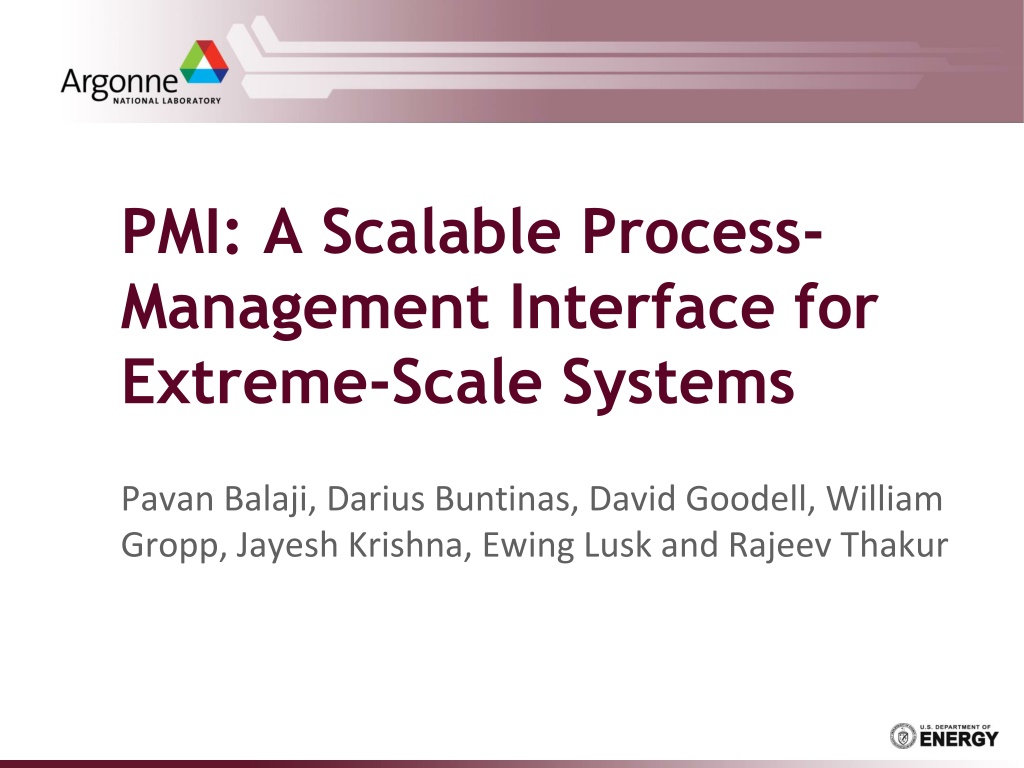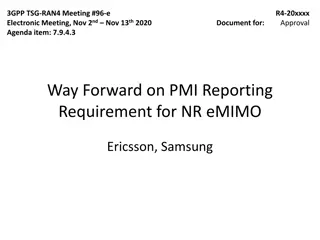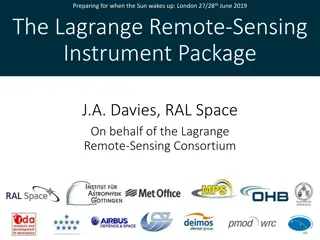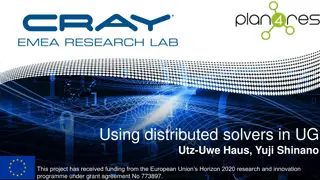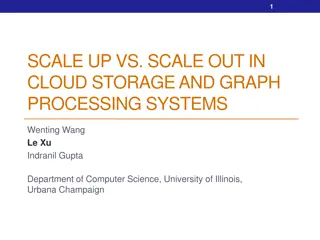PMI: A Scalable Process Management Interface for Extreme-Scale Systems
PMI (Process-Management Interface) is a critical component for high-performance computing, enhancing scalability and performance. It allows independent development of parallel libraries like MPI, ensuring portability across different environments. The PMI system model includes various components such as PMI API, Process Manager, and PMI Library, facilitating functions like process control, information exchange, and launch monitoring. PMI-2 introduces improved scalability and better hybrid MPI+threads interaction.
Download Presentation

Please find below an Image/Link to download the presentation.
The content on the website is provided AS IS for your information and personal use only. It may not be sold, licensed, or shared on other websites without obtaining consent from the author. Download presentation by click this link. If you encounter any issues during the download, it is possible that the publisher has removed the file from their server.
E N D
Presentation Transcript
PMI: A Scalable Process- Management Interface for Extreme-Scale Systems Pavan Balaji, Darius Buntinas, David Goodell, William Gropp, Jayesh Krishna, Ewing Lusk and Rajeev Thakur
Introduction Process management is integral part of HPC Scalability and performance are critical Close interaction between process management and parallel library (e.g., MPI) is important Need not be integrated Separation allows Independent development and improvement Parallel libraries portable to different environments 2
PMI Generic process management interface for parallel applications PMI-1 is widely used MVAPICH, Intel MPI, Microsoft MPI SLURM, OSC mpiexec, OSU mpirun Introducing PMI-2 Improved scalability Better interaction with hybrid MPI+threads 3
PMI Functionality Process management Launch and monitoring Initial job Dynamic processes Process control Information exchange Contact information Environmental attributes 4
System Model Microsoft MPI MPI Library MPICH2 Intel-MPI SCX-MPI MVAPICH2 PMI API Simple PMI SLURM PMI SMPD PMI PMI Library BG/L PMI Communication Subsystem OSC mpiexec OSU mpirun Hydra MPD SLURM SMPD Process Manager 6
Process Manager Handles Process launch Start and stop processes Forwarding I/O and signals Information exchange Contact information to set up communication Implementation May be separate components May be distributed E.g., PBS, Sun Grid Engine, SSH 7
PMI Library Provides interface between parallel library and process manager Can be system specific E.g, BG/L uses system specific features Wire protocol between PMI library and PM PMI-1 and PMI-2 have specified wire protocols Allows PMI lib to be used with different PM Note: wire protocol and PMI API are separate entities PMI implementation need not have wire protocol 8
PMI API PMI-1 and PMI-2 Functions associated with Initialization and finalization Init, Finalize, Abort Information exchange Put, Get, Fence Process creation Spawn 9
Information Exchange Processes need to exchange connection info PMI uses a Key-Value database (KVS) At init, processes Put contact information E.g., IP address and port Processes Get contact info when establishing connections Collective Fence operation to allow optimizations 10
Connection Data Exchange Example At init Proc 0 Puts(key= bc-p0 , value= 192.168.10.20;3893 ) Proc 1 Puts(key= bc-p1 , value= 192.168.10.32;2897 ) Proc 0 and 1 call Fence PM can collectively distribute database Later Proc 0 wants to send a message to Proc 1 Proc 0 does a Getof key bc-p1 Receives value 192.168.10.32;2897 Proc 0 can now connect to Proc 1 11
Implementation Considerations Allow the use of native process manager with low overhead Systems often have existing PM E.g., integrated with resource manager Minimize async processing and interrupts Scalable data exchange Distributed process manager Collective Fence provides opportunity for scalable collective exchange 12
New PMI-2 Features Attribute query functionality Database scope Thread safety Dynamic processes Fault tolerance 14
PMI-2 Attribute Query Functionality Process and resource managers have system- specific information Node topology, network topology, etc. Without this, processes need to determine this themselves Each process gets each other's contact-info to discover local processes O(p2) queries 15
PMI-2 Database Scope Previously KVS had only global scope PMI-2 adds node-level scoping E.g., keys for shared memory segments Allows for optimized storage and retrieval of values 16
PMI-2 Thread Safety PMI-1 is not thread safe All PMI calls must be serialized Wait for request and response Can affect multithreaded programs PMI-2 adds thread safety Multiple threads can call PMI functions One call cannot block the completion of another 17
PMI-2 Dynamic Processes In PMI-1 a separate database is maintained for each MPI_COMM_WORLD (process group) Queries are not allowed across databases Requires out-of-band exchange of databases PMI-2 allows cross-database queries Spawned or connected process groups can now query each other s databases Only process group ids need to be exchanged 18
PMI-2 Fault Tolerance PMI-1 provides no mechanism for respawning a failed process New processes can be spawned, but they have a unique rank and process group Respawn is critical for supporting fault- tolerance Not just for MPI but other programming models 19
Evaluation and Analysis PMI-2 implemented in Hydra process manager Evaluation System information query performance Impact of added PMI functionality over native PM Multithreaded performance 21
System Information Query Performance PMI-1 provides no attribute query functionality Processes must discover local processes O(p2) queries PMI-2 has node topology attribute Benchmark (5760 cores on SiCortex) MPI_Init();MPI_Finalize(); 22
Process Launch (5760-core SiCortex) Launch Time PMI Request Count 5,000 1,200 4,500 PMI-1 1,000 Requests (thousands) 4,000 PMI-2 Time (seconds) 3,500 800 3,000 2,500 600 2,000 400 1,500 1,000 200 500 0 0 1 4 16 64 256 1K 4K 1 4 16 64 256 1K 4K System Size (cores) System Size (cores) 23
Impact of PMI Functionality Systems often have integrated process managers Not all provide PMI functionality Efficient PMI implementation must make effective use of native process managers Minimizing overhead Benchmark (1600 cores on SiCortex) Class C BT, EP and SP Using SLURM (which provides PMI-1) Using Hydra over SLURM (for launch and management) plus PMI daemon 24
Runtime Impact of Separate PMI Daemons (1600 cores SiCortex) Absolute Performance Percentage Variation 200 6% 180 Variation in Execution Time Execution Time (seconds) 5% 160 140 SLURM 4% 120 Hydra 3% 100 80 2% 60 40 1% 20 0% 0 BT EP SP BT EP SP 25
Multithreaded Performance PMI-1 is not thread safe External locking is needed PMI-2 is thread safe Multiple threads can communicate with PM Hydra: lock only for internal communication Benchmark (8-core x86_64 node) Multiple threads calling MPI_Publish_name(); MPI_Unpublish _name() Work is fixed, number of threads increases 26
Multithreaded Performance 600 500 400 PMI-1 Latency ( s) 300 PMI-2 200 100 0 1 2 3 4 5 6 7 8 Thread Count 27
Conclusion 28
Conclusion We presented a generic process management interface PMI PMI-2: second generation eliminates PMI-1 shortcomings Scalability issues for multicore systems Issues for hybrid MPI-with-threads Fault tolerance Performance evaluation PMI-2 allows better implementations over PMI-1 Low overhead implementation over existing PM 29
